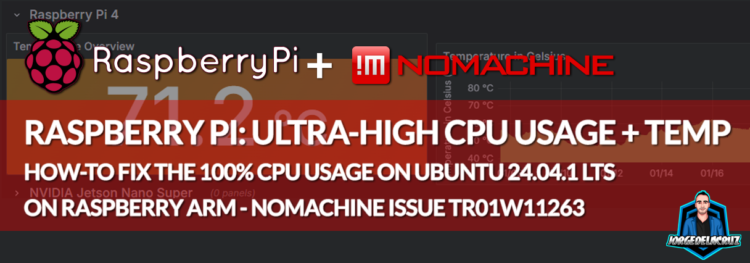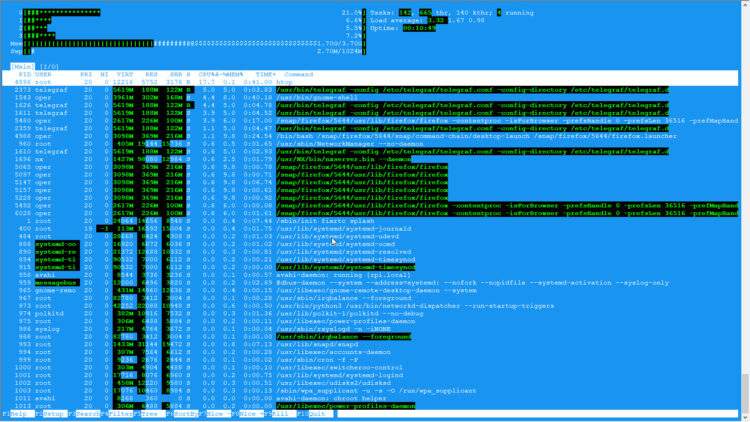 Greetings friends, I have recently upgraded my Raspberry Pi 4 to the latest Ubuntu 24.04 LTS, thinking that it should be stable enough, and solid. But right after upgrading, during the evening my Grafana kiosk mode, which is the whole purpose of this Raspberry Pi, was frozen.
Greetings friends, I have recently upgraded my Raspberry Pi 4 to the latest Ubuntu 24.04 LTS, thinking that it should be stable enough, and solid. But right after upgrading, during the evening my Grafana kiosk mode, which is the whole purpose of this Raspberry Pi, was frozen.
What it was worse, the Raspberry Pi was really hot, and I could see the last temperature metrics from the unit before got into this stuck mode, probably due heat.
 I could not find a motive, and I thought it was maybe something anecdotic, so I restart the unit. Jos to my surprise to find it today again on the same state, after a truly high temperatures for the last hours as you can see in the above image.
I could not find a motive, and I thought it was maybe something anecdotic, so I restart the unit. Jos to my surprise to find it today again on the same state, after a truly high temperatures for the last hours as you can see in the above image.
htop to the rescue
Running a quick htop point me to an staggering 100% CPU consumption by the process /usr/bin/gnome-shell, which for our misfortune it is related to the whole desktop environment. As this was not happening before the upgrade, one could think it was just some buggy gnome package, but an apt-get update && apt-get upgrade didn’t come with any new package or update.
Entering NoMachine
NoMachine TR01W11263 – High CPU usage with NoMachine v8.15 on Ubuntu
Just added the 21st of January, a few days ago at the time of writing this blog post. The guys from NoMachine wrote this known issue for users on Ubuntu 24.04.1 LTS ARM on Raspberry Pi. This is important because I am having the same Ubuntu version on the Jetson Nano and it is working without any issues, so it might be just for Raspberry Pi ARM version for some reason.
There is a few simple steps to resolve this:
sudo /etc/NX/nxserver --eglcapture no sudo systemctl restart display-manager
You can always log off and log in again, or reboot.
Perhaps not related, but I faced this strange issue just after that
cannot change mount namespace according to change mount (/run/user/1000/doc/by-app/snap.snapd-desktop-integration Jan 24 19:10:51 rpi snapd-desktop-i[13414]: Failed to do gtk init. Waiting for a new session with desktop capabilities. Jan 24 19:10:51 rpi snapd-desktop-i[13414]: Checking session /org/freedesktop/login1/session/_39... Jan 24 19:10:51 rpi snapd-desktop-i[13414]: Is a desktop session! Forcing a reload. Jan 24 19:10:51 rpi snapd-desktop-i[13414]: Checking session /org/freedesktop/login1/session/c2... Jan 24 19:10:51 rpi snapd-desktop-i[13414]: Is a desktop session! Forcing a reload. Jan 24 19:10:51 rpi snapd-desktop-i[13414]: Checking session /org/freedesktop/login1/session/_35... Jan 24 19:10:51 rpi snapd-desktop-i[13414]: Loop exited. Forcing reload.
On my case, I started receiving some strange errors, which might not be related to this simple line, but in any case, after doing that I entered on some sort of error after error and the display didn’t want to start working again, so I needed a bit more dramatic:
sudo apt install --reinstall ubuntu-desktop
After doing that, and a reboot, all is fine, but most important, CPU consumption is now super relaxed again, and the temperatures are much better:

 One of those blog entries that I truly hope it can help somebody on the same situation than me, with similar hardware and software.
One of those blog entries that I truly hope it can help somebody on the same situation than me, with similar hardware and software.
Thanks for reading it!

Leave a Reply